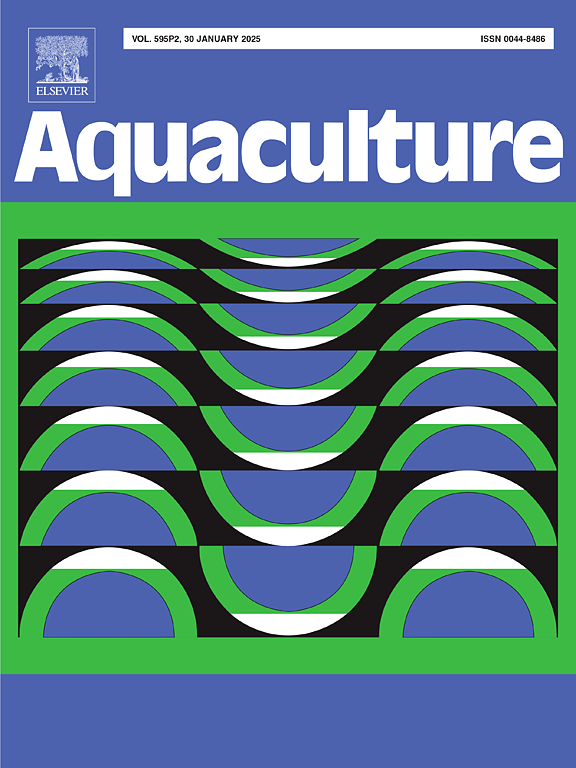自分泌/旁分泌成纤维细胞生长因子 1 (FGF1) 通过 AMPK 信号通路提高尿苷水平并通过 irf1 激活 upp2 启动子,从而增强高脂饮食喂养的虹鳟的全身脂质代谢
IF 3.9
1区 农林科学
Q1 FISHERIES
引用次数: 0
摘要
成纤维细胞生长因子 1(FGF1)在调节脊椎动物能量代谢方面的作用已得到公认,但它对鱼类代谢性脂肪肝的影响仍未得到研究。本研究探讨了自分泌/旁分泌细胞因子 FGF1 对高脂饮食(HFD)条件下虹鳟鱼(Oncorhynchus mykiss)全身脂质代谢的调节机制。实验鱼(共 540 尾)分为两个饮食组(低脂饮食组(LFD)和高脂饮食组(HFD)),并分为三个处理组:LFD + PBS(LFD 注射 PBS)、HFD + PBS(HFD 注射 PBS)和 HFD + rFGF1(HFD 注射重组 FGF1 蛋白)。虹鳟在摄入高纤维食物 6 周后体重增加,并出现新陈代谢失调的迹象。然而,与 HFD + PBS 组相比,外源 rFGF1 能显著降低肝脏指数(HSI)、全身、肌肉和肝脏粗脂肪含量、肝空泡形成、血清甘油三酯(TG)、血清低密度脂蛋白胆固醇(LDL-c)、血清甘油三酯(TG)和血清低密度脂蛋白胆固醇(LDL-c)、cpt1a, pparα, and acox1)的表达水平,同时提高 HDL-c 和脂肪酸氧化基因(cpt1a, pparα, and acox1)的表达水平(P <;0.05),从而减轻了 HFD 诱导的脂质积累,而对体重没有显著影响(P >;0.05)。血清代谢组学分析表明,rFGF1 能显著提高血清尿苷水平(P < 0.05),尿苷具有有效调节肝细胞脂质代谢的能力。此外,研究还发现 rFGF1 可通过 AMPK 信号通路促进肝脏尿苷的生物合成,同时通过下调干扰素调节因子 1(irf1)和改变其对尿苷磷酸化酶 2(upp2)的转录控制来调节尿苷的分解代谢。这些研究结果表明,rFGF1 可通过 AMPK 途径促进尿苷合成,并通过 IRF1-UPP2 信号转导部分抑制尿苷分解,从而缓解高脂饮食条件下虹鳟的肝脏脂质积累。本文章由计算机程序翻译,如有差异,请以英文原文为准。
Autocrine/paracrine fibroblast growth factor 1 (FGF1) enhances systemic lipid metabolism in rainbow trout fed with a high-fat diet by elevating uridine levels through the AMPK signaling pathway and activating the upp2 promoter via irf1
Fibroblast growth factor 1 (FGF1) is recognized for its role in regulating vertebrate energy metabolism, yet its impact on metabolic fatty liver disease in fish remains unexamined. This study investigates the regulatory mechanism of the autocrine/paracrine cytokine FGF1 on systemic lipid metabolism in rainbow trout (Oncorhynchus mykiss) subjected to a high-fat diet (HFD). Experimental fish (540 in total) were divided between two dietary groups (low-fat diet (LFD) and HFD) and categorized into three treatment groups: LFD + PBS (LFD injected with PBS), HFD + PBS (HFD injected with PBS), and HFD + rFGF1 (HFD injected with recombinant FGF1 protein). Over a 6-week period on the HFD, rainbow trout demonstrated weight gain and signs of metabolic dysregulation. However, compared to the HFD + PBS group, exogenous rFGF1 administration significantly lowered hepatosomatic index (HSI), whole-body, muscle, and liver crude fat content, hepatic vacuole formation, serum triglyceride (TG), serum LDL-c, and the expression levels of fatty acid synthesis (fas) and transport genes (cd36, fatp6), while elevating HDL-c and the expression levels of fatty acid oxidation genes (cpt1a, pparα, and acox1) (P < 0.05), thereby alleviating HFD-induced lipid accumulation without a significant impact on body weight (P > 0.05). Serum metabolomic analysis indicated that rFGF1 significantly elevated serum uridine levels (P < 0.05), with uridine demonstrating a capacity to regulate hepatocyte lipid metabolism effectively. Furthermore, rFGF1 was shown to enhance hepatic uridine biosynthesis through the AMPK signaling pathway, concurrently modulating uridine catabolism by downregulating interferon regulatory factor 1 (irf1) and altering its transcriptional control of uridine phosphorylase 2 (upp2). These findings suggest that rFGF1 mitigates hepatic lipid accumulation in rainbow trout under an HFD by promoting uridine synthesis via the AMPK pathway and partially inhibiting uridine catabolism through IRF1-UPP2 signaling.
求助全文
通过发布文献求助,成功后即可免费获取论文全文。
去求助
来源期刊

Aquaculture
农林科学-海洋与淡水生物学
CiteScore
8.60
自引率
17.80%
发文量
1246
审稿时长
56 days
期刊介绍:
Aquaculture is an international journal for the exploration, improvement and management of all freshwater and marine food resources. It publishes novel and innovative research of world-wide interest on farming of aquatic organisms, which includes finfish, mollusks, crustaceans and aquatic plants for human consumption. Research on ornamentals is not a focus of the Journal. Aquaculture only publishes papers with a clear relevance to improving aquaculture practices or a potential application.
 求助内容:
求助内容: 应助结果提醒方式:
应助结果提醒方式:


